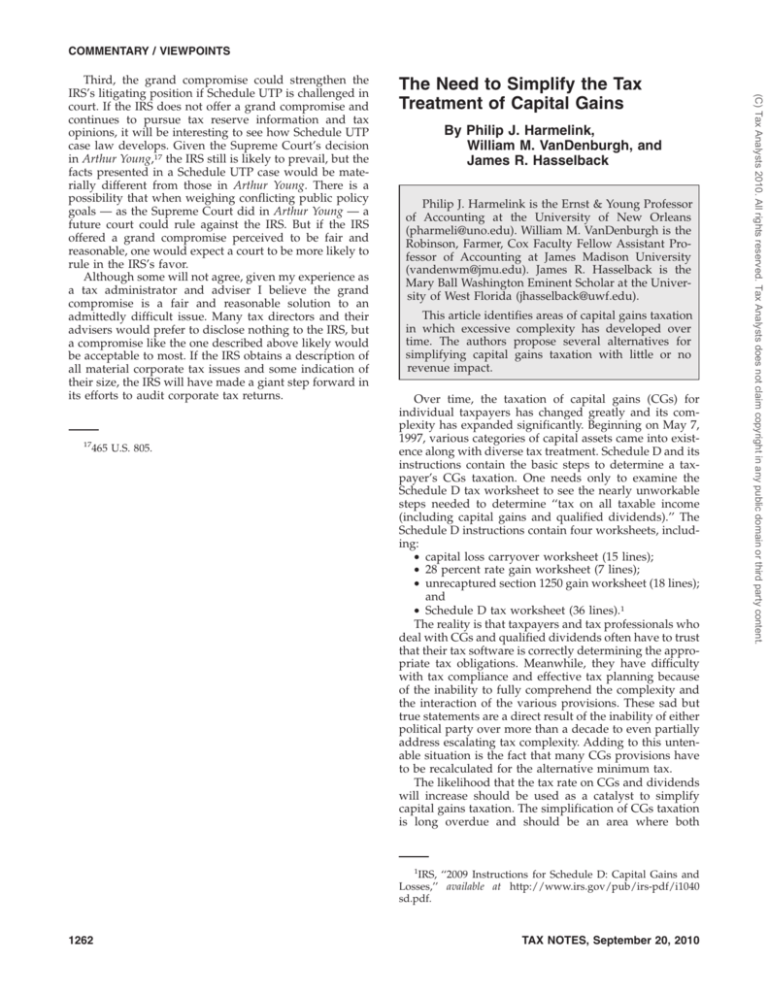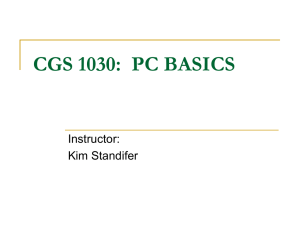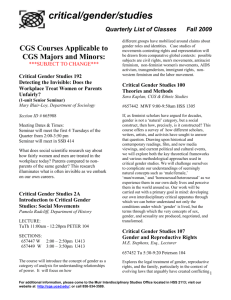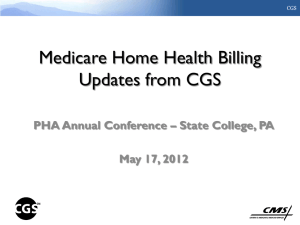
COMMENTARY / VIEWPOINTS
17
465 U.S. 805.
The Need to Simplify the Tax
Treatment of Capital Gains
By Philip J. Harmelink,
William M. VanDenburgh, and
James R. Hasselback
Philip J. Harmelink is the Ernst & Young Professor
of Accounting at the University of New Orleans
(pharmeli@uno.edu). William M. VanDenburgh is the
Robinson, Farmer, Cox Faculty Fellow Assistant Professor of Accounting at James Madison University
(vandenwm@jmu.edu). James R. Hasselback is the
Mary Ball Washington Eminent Scholar at the University of West Florida (jhasselback@uwf.edu).
This article identifies areas of capital gains taxation
in which excessive complexity has developed over
time. The authors propose several alternatives for
simplifying capital gains taxation with little or no
revenue impact.
Over time, the taxation of capital gains (CGs) for
individual taxpayers has changed greatly and its complexity has expanded significantly. Beginning on May 7,
1997, various categories of capital assets came into existence along with diverse tax treatment. Schedule D and its
instructions contain the basic steps to determine a taxpayer’s CGs taxation. One needs only to examine the
Schedule D tax worksheet to see the nearly unworkable
steps needed to determine ‘‘tax on all taxable income
(including capital gains and qualified dividends).’’ The
Schedule D instructions contain four worksheets, including:
• capital loss carryover worksheet (15 lines);
• 28 percent rate gain worksheet (7 lines);
• unrecaptured section 1250 gain worksheet (18 lines);
and
• Schedule D tax worksheet (36 lines).1
The reality is that taxpayers and tax professionals who
deal with CGs and qualified dividends often have to trust
that their tax software is correctly determining the appropriate tax obligations. Meanwhile, they have difficulty
with tax compliance and effective tax planning because
of the inability to fully comprehend the complexity and
the interaction of the various provisions. These sad but
true statements are a direct result of the inability of either
political party over more than a decade to even partially
address escalating tax complexity. Adding to this untenable situation is the fact that many CGs provisions have
to be recalculated for the alternative minimum tax.
The likelihood that the tax rate on CGs and dividends
will increase should be used as a catalyst to simplify
capital gains taxation. The simplification of CGs taxation
is long overdue and should be an area where both
1
IRS, ‘‘2009 Instructions for Schedule D: Capital Gains and
Losses,’’ available at http://www.irs.gov/pub/irs-pdf/i1040
sd.pdf.
1262
TAX NOTES, September 20, 2010
(C) Tax Analysts 2010. All rights reserved. Tax Analysts does not claim copyright in any public domain or third party content.
Third, the grand compromise could strengthen the
IRS’s litigating position if Schedule UTP is challenged in
court. If the IRS does not offer a grand compromise and
continues to pursue tax reserve information and tax
opinions, it will be interesting to see how Schedule UTP
case law develops. Given the Supreme Court’s decision
in Arthur Young,17 the IRS still is likely to prevail, but the
facts presented in a Schedule UTP case would be materially different from those in Arthur Young. There is a
possibility that when weighing conflicting public policy
goals — as the Supreme Court did in Arthur Young — a
future court could rule against the IRS. But if the IRS
offered a grand compromise perceived to be fair and
reasonable, one would expect a court to be more likely to
rule in the IRS’s favor.
Although some will not agree, given my experience as
a tax administrator and adviser I believe the grand
compromise is a fair and reasonable solution to an
admittedly difficult issue. Many tax directors and their
advisers would prefer to disclose nothing to the IRS, but
a compromise like the one described above likely would
be acceptable to most. If the IRS obtains a description of
all material corporate tax issues and some indication of
their size, the IRS will have made a giant step forward in
its efforts to audit corporate tax returns.
COMMENTARY / VIEWPOINTS
Table 1. History of Maximum Capital Gains (CGs) and Ordinary Income (OI) Tax Rates
19791981
19821986
1987
19881990
19911992
19931997
CGs
28%
20%
28%
33%
28%
28%
OI
70%
50%
35.5%
33%
31%
39.6%
political parties should be able to compromise (although
the art of bipartisanship is often absent). With the coming
expiration of the current tax cuts and the reversion to
pre-2001 tax laws, the necessity for major tax law changes
is apparent to most tax professionals. Congress and the
Obama administration, however, have simply ignored
the reality of this ticking time bomb.
This article examines the history of individual CGs
taxation and identifies areas in which excessive complexity has grown over time. An examination of the history of
CGs taxation reveals that various tax approaches have
been employed. The authors conclude by proposing
several possible alternatives that would simplify CGs
taxation with little or no revenue impact.
History of Capital Gains Treatment
Although capital gains taxation for individual taxpayers has generally enjoyed special treatment of one
form or another for 85 years, this section of the article
traces the major tax treatments in effect for approximately the last 30 years. As will be seen, various rates and
tax approaches have been employed, and the system has,
to a degree, built superfluous complexity on itself. Table
1 summarizes the various maximum CGs and ordinary
income tax rates used since 1979.
For 1979-1981, the maximum CGs rate was effectively
28 percent because taxpayers were allowed to obtain a 60
percent deduction for the excess of their net long-term
CGs (net LTCGs) over their net short-term capital losses.
With 40 percent of the net LTCGs being included, and
with a maximum marginal ordinary income tax rate of 70
percent, the maximum CGs rate was 28 percent.
Early in the Reagan administration, when the top
ordinary income rate declined to 50 percent, the 40
percent of net LTCGs included in income resulted in a
maximum rate of 20 percent. This lasted until 1987, when
the top maximum CGs rate rose to 28 percent while the
top ordinary income rate was 38.5 percent. From 1988 to
1990, there were no special CGs rates. The maximum
ordinary income rate was 28 percent. A surtax raised the
maximum rate for some individual taxpayers to 33
percent.
In 1991-1992, the top ordinary income rate was 31
percent, and the top CGs rate was 28 percent, where it
remained through May 6, 1997. However, at the beginning of the Clinton administration, the top ordinary
income rate increased to 39.6 percent, where it remained
through 1999. Meanwhile, effective May 7, 1997, the top
CGs rate went down to 20 percent for those taxpayers in
the 28 percent and higher tax brackets and 10 percent for
those in the 15 percent and lower tax brackets; those rates
remained in effect through 2001. The top marginal ordinary income rate declined minimally to 39.1 percent in
2000-2001 and to 38.6 percent in 2002. In 1997, there was
a short-lived attempt to classify CGs as short-term (less
TAX NOTES, September 20, 2010
19981999
20% or
10%
39.6%
20002001
20% or
10%
39.1%
2002
20% or
10%
38.6%
20032007
15% or
5%
35%
20082010
15% or
0%
35%
than 12 months with ordinary income rates), intermediate term (less than 18 months with a 28 percent maximum
rate), and long-term (more than 18 months with a 20
percent maximum rate). This provision resulted in such
taxpayer outrage that it was eliminated the following
year.
Additional CGs rates were established for purchases
after 2000. If an asset purchased after 2000 was held
longer than five years, it qualified for an 18 percent
maximum CGs rate. For taxpayers in the 15 percent
bracket, the maximum rate was 8 percent (instead of 10
percent) beginning in 2001 as long as the asset was held
more than five years (regardless of when the asset was
acquired). These provisions no longer applied when the
CGs rates were lowered in 2003, but could apply in 2011.
During the Bush administration, starting on May 6,
2003, the top CGs rate went to 15 percent for taxpayers in
the 28 percent or higher marginal tax brackets and to 5
percent for taxpayers in the 15 percent or lower tax
brackets. Those rates remained through 2007. Meanwhile, the top marginal ordinary income rate declined to
35 percent during the 2003-2010 time period. In 2003,
qualified dividends were also given the same preferential
tax treatment as CGs. In 2008, the 15 percent CGs rate for
taxpayers in the 28 percent or higher tax bracket was
extended, and the CGs rate decreased to 0 percent for
taxpayers in the 15 percent or lower tax bracket. Originally, the preferential rates on CGs and qualified dividends were due to expire in 2008.
Current and Forthcoming Taxation of Capital Gains
Long-term CGs and qualified dividends are taxed at
15 and 0 percent, respectively. However, after 2010,
long-term CGs will generally be taxed at 20 percent (10
percent for taxpayers in the 15 percent tax bracket,
barring any change by Congress). Dividends will be
taxed at the taxpayer’s ordinary income tax rate regardless of his tax bracket. The qualified five-year 18 percent
CGs rate (8 percent for taxpayers in the 15 percent tax
bracket) will be reinstated. When one adds the various
CGs categories (many of which were created in 1997) and
the tax treatment of CGs and losses, the complexity of
these transactions only grows. Currently, four different
preferential tax rates can apply to various categories of
LT CGs (0, 15, 25, and 28 percent).
Special Treatment Starting in 1997
Starting after May 6, 1997, special CGs rate categories
that were not eligible for the lowest CGs rates went into
effect, greatly increasing the complexity of CGs treatment. Preferential small-business CGs and loss provisions have also been added over time.
Taxed at Potentially Different Rates
Collectibles gains. Gains on stamps, antiques, gems,
and most coins are generally taxed up to the maximum
1263
(C) Tax Analysts 2010. All rights reserved. Tax Analysts does not claim copyright in any public domain or third party content.
Maximum
COMMENTARY / VIEWPOINTS
1264
depreciation was $20,000, and the depreciation for 1976
through 2009 was $679,926, for a total depreciation of
$709,926 and total straight-line depreciation of $700,000.
Thus, the taxpayer would have two tax bases ($90,074
under the modified accelerated cost recovery system and
$100,000 for straight-line). Therefore, the excess depreciation for the total time period was $9,926, and that would
be recaptured as ordinary income. The remaining depreciation of $700,000 would be taxed at a maximum rate of
25 percent, and the remaining gain of $190,074 would be
section 1231 gain that would be eligible for the lowest
maximum CGs rate (currently 15 percent).
Example 2: If the above taxpayer sold the building for
only $95,000, all the recognized gain of $4,926 would be
recognized as ordinary income and there would be no
gain taxed in the 25 percent or 15 percent categories.
However, if the building was sold for only $80,000, there
would be a recognized loss of $10,074, which would be a
section 1231 loss, and nothing would be recaptured as
ordinary income or as unrecaptured section 1250 gain.
The taxpayer would have an ordinary loss if this were the
only section 1231 transaction for the year. Multiple section 1231 transactions complicate the calculations with
the required nettings.
Example 3: If a taxpayer purchased a nonresidential
building in 1983 (accelerated cost recovery system time
period) for $800,000 and fully depreciated it under an
accelerated method, and then sold it in 2010 for $1
million, there would be a recognized gain of $1 million.
There is $800,000 recaptured as ordinary income (because
accelerated depreciation was used), and the remaining
$200,000 is section 1231 gain, which is eligible for potential 15 percent maximum taxation. However, if straightline depreciation was used, the gain would consist of
$800,000 taxed at the 25 percent maximum bracket, and
$200,000, which would be eligible for 15 percent maximum taxation. Similar to the nonresidential building
computation, if the property was a residential rental
building, it would get the same treatment of $800,000
taxed at a 25 percent maximum rate, and $200,000 at a 15
percent rate regardless of whether the building was
depreciated under an accelerated method or under the
straight-line method.
These examples show how quickly CGs tax compliance and tax planning can become difficult. The interplay
of these various code sections (sections 1221, 1231, 1245,
1250, and others) stretch the workability of the U.S. tax
system for little or no real purpose, both from a tax
administration perspective and a tax compliance perspective.
Tracking the Baskets
In addition to various potential CGs tax rates, there are
different types of property that result in the need to keep
track of baskets or categories:
• Short-term basket. This is a combination of all
short-term CGs and losses and short-term capital
loss carryovers.
• 28 percent basket. This is calculated by adding all
the collectibles gains and losses, section 1202 gains,
and long-term capital loss carryovers.
• 25 percent basket. This is the total of unrecaptured
section 1250 gains, which could be up to the total
TAX NOTES, September 20, 2010
(C) Tax Analysts 2010. All rights reserved. Tax Analysts does not claim copyright in any public domain or third party content.
rate of 28 percent. However, an exception is made for
some newly minted gold and silver coins issued by the
federal government and coins issued under state law.
Section 1202 gains. When a taxpayer sells certain
small-business stock (section 1202 stock) that has been
held for more than five years, 50 percent of the gain is
excluded from gross income. The remaining gain from
the sale of this stock is taxed at a maximum rate of 28
percent. As can be expected, this provision has numerous
restrictions (for example, the issuing company must have
assets less than $50 million, $10 million in gain or 10
times the basis limitation, and nonapplicability for certain businesses, etc.). The percentage exclusion is increased to 75 percent for stock acquired after February 11,
2009, and before January 1, 2011.
Section 1231 gains. Section 1231 applies to business
assets that are sold. When netting section 1231 gains and
losses, if the netting is positive, the gain is treated as a
capital gain (after the sections 1245 and 1250 recapture
rules have been applied). If the netting is negative, the
loss is ordinary.
Section 1244 losses. When a taxpayer sells a smallbusiness stock at a loss, the capital loss limitations do not
apply for a portion of the loss. Individuals can deduct up
to $50,000 of the loss as ordinary ($100,000 if married
filing jointly) on an annual basis. Here, the issuing
company must have less than $1 million in total capitalization (as opposed to a $50 million asset ceiling for
section 1202), as well as comply with other restrictions.
Section 1245 gains. When tangible personal property
(for example, a business asset) is sold at a gain, all prior
allowable depreciation, whether taken or not, is subject to
ordinary income recapture.
Section 1250 gains. Complicated ordinary income
recapture rules apply for section 1250 assets (real property), especially if purchased before 1987 when accelerated depreciation was allowed.
Unrecaptured section 1250 gains. Under section 1250,
real estate gains are taxed at a maximum rate of 25
percent for individual taxpayers. The maximum amount
taxed at 25 percent is the total depreciation taken on the
property not to exceed the recognized gain. This maximum amount is reduced by the amount that was treated
as ordinary income under section 1250 depreciation
recapture rules. That ordinary income portion would be
limited by the total amount of recognized gain.
These provisions and their interplay can result in
many perplexing tax consequences when a long-term
asset is sold. Even more disconcerting is that section 1231
gains treatment for business assets often do not even
occur because of section 1245 depreciation recapture
(section 1245 assets generally are sold at little or no gain).
The complicated section 1250 recapture provisions apply
only if the building was acquired before 1987. The
following three examples describe various outcomes
based on selling a nonresidential building property in
2010 and the complex tax calculations that can be involved.
Example 1: Assume the taxpayer bought a nonresidential building in 1975 for $800,000 with an estimated life of
40 years, used the 150 percent declining balance method
of depreciation, and sold it in early 2010 for $1 million.
The depreciation taken in 1975 was $30,000, straight-line
COMMENTARY / VIEWPOINTS
Situation 1
Situation 2
Situation 3
Short-Term
Capital Gain
28% Gain
25% Gain
15% Gain
($24,000)
$0
($24,000)
$10,000
$10,000
$10,000
$6,000
$6,000
$6,000
$4,000
$4,000
$4,000
$2,000
$2,000
$10,000
depreciation taken on the sale of section 1250 assets
but not to exceed the recognized gain that exceeds
the amount of the gain recaptured at the taxpayer’s
ordinary rate.
• 15 percent basket. This contains long-term CGs and
losses not included in the other baskets.
Further nettings have to be considered if there are net
losses. A net loss from the 28 percent basket is used to
reduce gains from the 25 percent basket and then to
reduce net gains from the 15 percent basket. A net loss
from the 15 percent basket is used to reduce gains from
the 28 percent basket and then to reduce gains from the
25 percent basket. Net short-term capital losses are used
to reduce gains from the 28 percent basket and then to
reduce gains from the 25 percent basket, and then to
reduce net gains from the 15 percent basket.
Net short-term CGs are used to reduce any net losses
in the 28 percent basket and then the 15 percent basket.
Any net capital gain that remains in a particular basket is
taxed at that basket’s marginal tax rate. Any excess loss
that remains is deductible, up to $3,000 for married
couples filing jointly and single taxpayers (or $1,500 for
married taxpayers filing separately).
Example 4: Assume a single 35 percent marginal tax
bracket taxpayer, a $350,000 salary, and the following
CGs and losses faces the three situations in Table 2.
In Situation 1, the taxpayer has a net short-term capital
loss of $14,000, which is used to offset the $6,000 28
percent gain, the $4,000 25 percent gain, and the $2,000 15
percent gain to leave a $2,000 loss that is deductible by
the taxpayer. In Situation 2, the taxpayer has four gains:
a net short-term capital gain of $10,000 that is taxed at the
35 percent marginal tax rate, a gain of $6,000 that is taxed
at the 28 percent marginal tax rate, a $4,000 gain that is
taxed at the 25 percent marginal tax rate, and a $2,000
gain that is taxed at the 15 percent marginal tax rate. In
Situation 3, the taxpayer has the net short-term capital
loss of $14,000, which is used to offset the $6,000 28
percent gain, the $4,000 25 percent gain, and $4,000 of the
15 percent gain, thereby leaving $6,000 of the 15 percent
basket to be taxed at a 15 percent marginal tax rate.
Example 4 shows the complexity and the diverse
outcomes that occur when calculating the tax results for
the tax baskets. There are an almost infinite number of
possibilities when applying the netting rules, depending
on a taxpayer’s gains and losses. Complying with the
excessively complicated tax rules that now apply to the
capital transaction provisions requires real diligence,
along with luck, when a taxpayer has multiple tax
baskets in which to group the capital gains and losses.
These complications make it extremely difficult for
taxpayers to understand, much less comply with, the
various CGs code sections. The Schedule D worksheet is
virtually impossible for the average taxpayer and even
tax return preparers to understand. Ford, Hulse, and
TAX NOTES, September 20, 2010
Pope’s Tax Notes article on the taxation of collectibles
demonstrates that the misunderstandings in their taxation is likely ‘‘an unintended consequence of a complicated system of taxing long-term capital gains.’’2 Even
though most taxpayers and nearly all tax return preparers now use some type of computerized tax calculation service, taxpayers do not understand what is really
occurring, and this complication makes it difficult for
them to do proper tax planning.
Other Complications
While preferential CGs rates apply for AMT purposes,
several of the gain or loss provisions must be reconfigured. For a section 1202 gain, 7 percent of the gain is
added back to taxpayers’ AMT income.3 For section 1245
property, there are two tax bases (one for AMT and one
for regular tax basis). Over the life of the property, the
same amount of depreciation is taken under both approaches, but the annual amount varies. Initially, this
results in an increase to AMT income, but then the
situation reverses. If the property is sold before being
fully depreciated, yet another AMT adjustment is required. Example 5 shows the complexity created for tax
planning and compliance.
Example 5: Assume a taxpayer purchases business
property with MACRS five-year class life for $100,000 in
2008 and sells it in 2009 for $68,000. Assuming the
half-year convention applies, the taxpayer’s depreciation
deduction for regular tax purposes (assuming no bonus
depreciation or section 179 election) for years 2008 and
2009 is $20,000 and $16,000, respectively. For AMT purposes, the depreciation is limited in 2008 and 2009 to
$15,000 and $12,750. The taxpayer has two different tax
bases for the asset sold. For regular tax purposes, his
basis is $64,000, and for AMT purposes it is $72,250. Thus,
for regular tax purposes, the sale results in an ordinary
income of $4,000, and for AMT purposes there is a section
1231 loss of $4,250.
Unfortunately, the trend for more specialized CGs
categories has political appeal. For example, President
Obama’s fiscal 2011 budget proposed a new 0 percent
CGs tax rate for ‘‘qualified small-business stock’’ acquired after February 17, 2009.4
2
Allen Ford, David S. Hulse, and Thomas R. Pope, ‘‘What’s
the Tax Rate on Collectibles Gain?’’ Tax Notes, Mar. 1, 2010, p.
1067, Doc 2010-1824, 2010 TNT 40-6.
3
IRS, ‘‘2009 Instructions for Form 6251: Alternative Minimum Tax — Individuals,’’ available at http://www.irs.gov/
pub/irs-pdf/i6251.pdf, p. 4.
4
‘‘Federal Tax Alert: President’s FY 2011 Budget’s Tax Proposal, Part I,’’ RIA Tax Alerts Developments, Feb. 8, 2010.
1265
(C) Tax Analysts 2010. All rights reserved. Tax Analysts does not claim copyright in any public domain or third party content.
Table 2
Short-Term
Capital Loss
COMMENTARY / VIEWPOINTS
Percentage of Total AMT Preferences and Adjustments
Projections for Selected Years
AMT Preferences and Adjustments
2006
2007
2010
State and local tax deduction
Personal exemptions
Miscellaneous itemized expenses deduction
Standard deduction
Medical expense deduction
Refund of taxes
All other preferences and adjustments
Total
62.7%
22.4%
11.4%
1.2%
0.5%
-3.5%
5.3%
94.7%
Recommendations
The above discussion shows that the whole area of
CGs and losses is excessively complicated and should be
revised. One could argue that it would be more straightforward to return to a system similar to what was in place
before 1998. Various alternatives are possible, all of which
would be easier and less cumbersome than the present
system. One solution would be to eliminate a portion of
CGs from taxation and tax the rest at ordinary rates (the
system in place before 1987). Another would be to
increase the top CGs tax rate along with eliminating the
various categories of CGs while possibly retaining a 0
percent CGs tax rate for lower-income taxpayers. Other
actions to consider would include completely eliminating
special treatment for CGs, eliminating depreciation recapture, increasing the capital loss deduction, and eliminating AMT adjustments for depreciation.
Alternatives to Simplify Capital Gains Taxation
Alternative 1: One solution to reduce complexity
would be to eliminate the 28 and 25 percent baskets and
have CGs taxation revert to a system that allows a 60
percent deduction for net LTCGs, with the remaining 40
percent taxed at the taxpayer’s marginal tax bracket.
Under the current tax rate structure, with a maximum
ordinary rate of 35 percent, this would mean the maximum CGs tax rate would be 14 percent (40 percent of 35
percent). A 50 percent deduction and an inclusion of 50
percent would mean the maximum tax rate would be 17.5
percent (50 percent of 35 percent). If the predictions for
changes for the future were to actually include increases
in marginal tax rates, and if the top ordinary marginal
rate were 40 percent, that would be a maximum CGs tax
rate of 16 percent (40 percent of 40 percent) with a 60
percent deduction, and a 20 percent maximum CGs rate
(50 percent of 40 percent) with a 50 percent deduction.
Alternative 2: Another solution would be to eliminate
the 28 and 25 percent baskets and impose a CGs rate up
to a specific tax rate on the net CGs (possibly 20 percent,
which has been discussed recently). That is, taxpayers in
the 15 percent ordinary income tax bracket would be
taxed up to the amount of 15 percent, and taxpayers in
higher brackets would be taxed at the maximum rate of
20 percent on net CGs. However, if it were deemed that
taxpayers in the 15 percent bracket should also have a
special concession, we could revert to the taxation of net
CGs at 5 or 0 percent. A 0 percent bracket would mean
small businesses would receive capital gains taxation
1266
44.1%
42.7%
7.3%
6.3%
0.7%
-2.6%
1.6%
98.4%
44.4%
44.4%
6.8%
5.2%
0.9%
-2.6%
0.8%
99.2%
2017
39.3%
47.5%
6.9%
6.8%
1.2%
-2.4%
0.7%
99.3%
relief without the complexity of creating and complying
with a new code section as proposed in the fiscal 2011
budget.
Alternative 3: The preference that CGs taxation provides could be eliminated (which would be simplicity at
its core). While this essentially occurred in 1988-1990, this
alternative would likely meet strenuous political objections from both political parties. Strong economic arguments for preferential treatment of CGs can be made as
well.
Other Recommendations
In the area of capital losses, the $3,000-per-year restriction should be increased. This would ease data requirements for both the IRS and taxpayers. While some have
advocated indexing this amount, in general, indexing
this loss figure does not facilitate simplification. However, an increased loss limitation to around $10,000 per
year is long overdue given the economic situation and
the recent volatility in the stock market. Eliminating the
depreciation recapture provisions should be seriously
considered, as this would increase simplification (for
section 1245 property and especially for section 1250
property purchased before 1987).
In the AMT area, different depreciation methods and
the recalculation of gains or losses on the sale of section
1231 assets result in excess record-keeping requirements
for taxpayers and require a set of at least two different
long-term asset bases (this could last as long as 40 years
for some section 1250 assets purchased pre-1987). The
disconcerting nature of the complexity and cross purposes that have occurred in the code is that the interplay
of the various provisions between AMT and regular tax
can often result in little net revenue gain for the government. In a 2007 Joint Committee on Taxation report, the
AMT preferences and adjustments required for potential
CGs issues (sections 1231, 1202, and passive activities)
were expected to be less than 1 percent of all AMT
preferences and adjustments in 2010 and 2017 (see the
‘‘all other preferences and adjustments’’ in Exhibit 1).5 In
other words, different AMT calculations serve little or no
long-term purpose to the U.S. government’s revenue
5
JCT, ‘‘Present Law and Background Relating to the Individual Alternative Minimum Tax,’’ JCX-10-7, Mar. 2007, Doc
2007-5732, 2007 TNT 44-16.
TAX NOTES, September 20, 2010
(C) Tax Analysts 2010. All rights reserved. Tax Analysts does not claim copyright in any public domain or third party content.
Exhibit 1. JCT’s 2007 Projections on AMT Adjustments
COMMENTARY / VIEWPOINTS
(C) Tax Analysts 2010. All rights reserved. Tax Analysts does not claim copyright in any public domain or third party content.
stream, but they do cause very real costs in terms of
compliance — or, conversely, noncompliance — as well
as ambiguity and confusion regarding tax planning issues. Therefore, requirements for these AMT adjustments
should be eliminated.
Conclusion
As this article demonstrates, the taxation of CGs
quickly becomes very complicated. Eliminating various
categories with potential CGs treatment and different tax
rates would simplify what has become a mostly impractical compliance situation for taxpayers with CGs and
capital losses. Adding to this madness is that many
depreciation and CGs calculations often have to be
reconfigured for AMT tax purposes. The reality is that tax
software is used to calculate the results of CGs transactions, and taxpayers and tax practitioners are often forced
to blindly rely on the results.
We believe that our proposed alternatives 1 or 2 are
very workable and would greatly simplify the tax system. Further, this would be an appropriate time to
eliminate depreciation recapture provisions, increase the
capital loss deduction to $10,000, and eliminate AMT
depreciation adjustments. With the virtual certainty of
higher CGs rates in 2011 through reversion to earlier tax
treatment if no legislation occurs, Congress and the
administration now have an excellent opportunity for
significant and long overdue simplification in the CGs
area. Of course, this outcome would require political
compromise by both parties, which has proven to be
difficult.
TAX NOTES, September 20, 2010
1267






